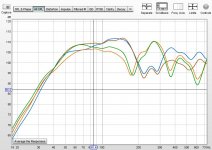Agree. The meat is missing. I would be much grateful for less efficient box that goes truly down to 40Hz. At 35Hz it is still fun, at 30Hz one hits the diminishing return wall. Well, for that reason and lack of development (it gets very expensive to do on my own) pushes me to still stay with bassreflex boxes.
For the same reason I've taken a closer look at offset tapered / mass loaded transmission lines. Same benefits as reflex boxes, but you're able to sim, and therefore reduce, the impact of the higher pipe resonance of the vents on the overall response. The OSTL also seems to offer the additional advantage of reducing THD in the passband, as suggested from some measurements I've taken of two of my builds.
Hi again everyone ! In order to compensate the "not so linear" response of the enclosure between 150Hz and 1Khz (and it's by design in all tapped horn, what to do) and as my space is very limited, I was thinking including a 10" midrange driver in the tham15.
Here are the specs of it : RCF MR10N301 - 10" Sealed Basket
I am aware it's very risky and would change the air volume and so on it's bass response, hence the following questions :
- Is it a good idea ?
- If yes, where would be it's best position ?
- If no, any idea of where I could "fit" these 10" (they don't need any enclosure)
Here are the specs of it : RCF MR10N301 - 10" Sealed Basket
I am aware it's very risky and would change the air volume and so on it's bass response, hence the following questions :
- Is it a good idea ?
- If yes, where would be it's best position ?
- If no, any idea of where I could "fit" these 10" (they don't need any enclosure)
Hello. Depends on how you do it. It is not very clear to me. But putting the driver anywhere in/on the "stock" THAM. You need to add another enclosure.
Brian Steele: at this point I'm in such small volumes that even driver dimensions make it impossible to make as small enclosure of any other type as bassreflex. The ultimate thinking is to put speakers all around the cube, to finish the power density madness once for all.
Brian Steele: at this point I'm in such small volumes that even driver dimensions make it impossible to make as small enclosure of any other type as bassreflex. The ultimate thinking is to put speakers all around the cube, to finish the power density madness once for all.
Looks like the -3dB point is around 50 Hz for the raw response.
Did you take an impedance curve as well? That will also show how close (or not) the response of the built THAM15 is to the sim'd response.
Pro audio woofer boxes that have an F3 around 50 Hz are interesting, in that they're fine for most purposes. However, compare them to a 40 Hz (or lower) capable box, and most people would prefer the box that goes lower (based on my albeit unofficial polling). My POC6 build has a similar cutoff frequency, so it was fairly easy to do the comparison between it and my POC3, which can get down to 40 Hz.
In this measurement the -3db point is at ~47 hz, with equing I could get it to around 43hz. But sure, 30hz would be appealing.
In this measurement the -3db point is at ~47 hz, with equing I could get it to around 43hz. But sure, 30hz would be appealing.
That's why taking the impedance curve is important. 43 Hz is below the THAM's usable passband. It's lowest resonance frequency is above above 43 Hz.
Hi everyone ! Little question about the THAM series and EQ, as I was thinking using a THAM as a sub AND a midbass enclosure.
Anybody tried to calculate, set up an EQ for an DSP/Crossover in order to correct the rollercoasting response from 200Hz to 800Hz and get it as flat as possible ?
I don't know at which extend it's possible to correct this with devices such as MiniDSP
In black, the actual response. In grey, the aimed correction
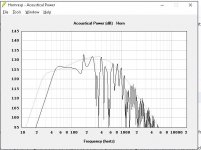
Anybody tried to calculate, set up an EQ for an DSP/Crossover in order to correct the rollercoasting response from 200Hz to 800Hz and get it as flat as possible ?
I don't know at which extend it's possible to correct this with devices such as MiniDSP
In black, the actual response. In grey, the aimed correction

I would not recommend using the THAM15 above 150 Hz, even if you manage to EQ it reasonably flat. Look at the Phase and GD graph in Hornresp and you will see why. It sounds horrible above the first peak.
The THAM15 is usually useful down to 40 Hz with a small touch of EQ, but you will need a steep HP filter if you want to push it down to 40 Hz.
The THAM15 is usually useful down to 40 Hz with a small touch of EQ, but you will need a steep HP filter if you want to push it down to 40 Hz.
Hi everyone ! Little question about the THAM series and EQ, as I was thinking using a THAM as a sub AND a midbass enclosure.
Don't do it. THs are basically unusable that that "noisy" area of their frequency response.
Roger that, thank you ^^, I'll stick with a vented type enclosure, unless someone has a better idea to reach theses 800Hz with high output ?
Direct radiator or straight horn good for 100-800Hz.
You still need sub though..
My thoughts are that this is also most likely true for TH's and principle related designs showing a reasonable flat simulated SPL response above the indicated pass band since there may be (and most often are) time domain related response issues in that apparently flat SPL region, thus still rendering such designs quite a challenge to integrate with a top system in that particular region, again the GD and phase response plots will tell you if that is the case.I would not recommend using the THAM15 above 150 Hz, even if you manage to EQ it reasonably flat. Look at the Phase and GD graph in Hornresp and you will see why. It sounds horrible above the first peak.
A flat SPL response in the desired x-over region is only useful if the time domain response in that region is equally flat, otherwise, and if your physical alignment is not spot on by chance, the energy might act destructive compared to what ever you want to cross it over to, in such case a dip in the response is more favorable since it does not fool you into attempting such a task.
Last edited:
Finished my first Tham15 mk1. Lots of punch even at low power amp (my measuring amplifier gives only 2 x 25Wrms), nice sounding box and it does reasonably low.
Quick measurements from the mouth, mic was at 10cm distance. Two different drivers, RCF L15P540 (orange) and RCF L15P200A / 4ohm (green).
It indeed looks like the enclosure itself is dominating more than the driver used, so many drivers might work. But we'll see how it does at high power levels!
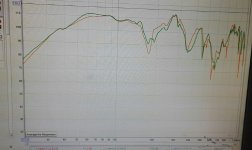
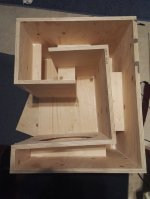
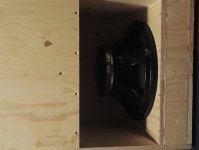
Quick measurements from the mouth, mic was at 10cm distance. Two different drivers, RCF L15P540 (orange) and RCF L15P200A / 4ohm (green).
It indeed looks like the enclosure itself is dominating more than the driver used, so many drivers might work. But we'll see how it does at high power levels!



Last edited:
Cubo15 extended vs. Tham 15
View attachment 787891
Brown: Cubo15 extended, RCF L15P200A, driver in chamber
Blue: Cubo 15 extended, RCF L15P540, driver in chamber
Green: Tham 15, L15P200A
Orange: Tham 15, L15P540
What are the measurement conditions?
What's the dimensions of the Cubo15 extended compared to the THAM15?
The Cubo15 with the RCF L15200A seems like the best response, according to the graph. The results also suggest that the mouth of the THAM15 might be a bit undersized for the drivers used for the testing.
Note: if you think of both of this designs as series-tuned 6th order bandpass systems with lousy out of band "noise" suppression, their response curves take on a slightly different significance
- Home
- Loudspeakers
- Subwoofers
- THAM15 - a compact 15" tapped horn
